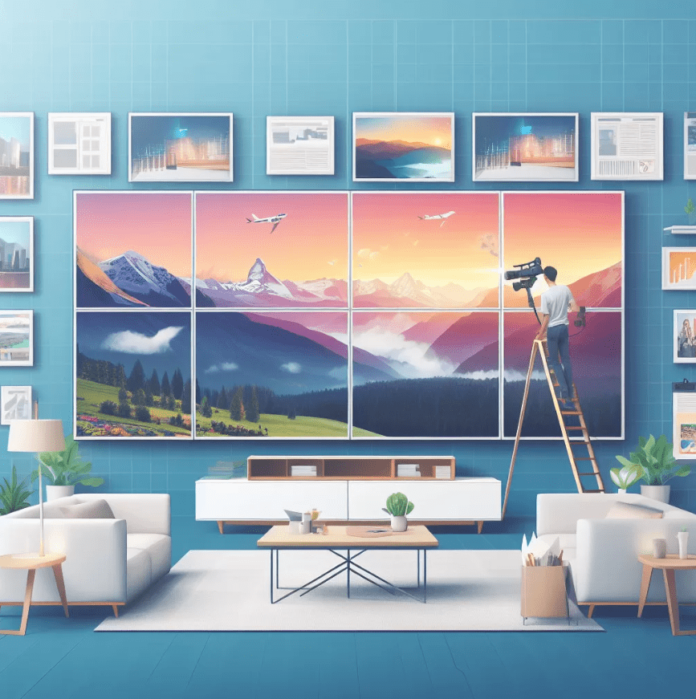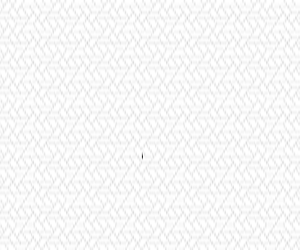Video walls are a powerful technique for capturing attention and presenting content in a dynamic and beautiful way in the world of digital signage. multimedia presentations and immersive advertising that exist today Video walls typically consist of multiple screens arranged in a straight grid. However, more and more creative arrangements are being created. increasingly popular This allows designers to play with unique layouts that combine vertical and horizontal aspect ratios. A particularly eye-catching arrangement is a video wall with two vertical monitors on either side of a central horizontal projection image. This arrangement not only enhances the visual experience. but also allows for the creation of a variety of media Also has variations. A video wall with 2 portrait and 1 landscape display creates dynamic, versatile, and visually engaging content presentations for any environment. This article discusses the use cases. design benefits and technical side of a video wall setup with two vertical monitors and one horizontal monitor. By knowing how to leverage this layout, you can create an engaging visual environment that engages visitors and maximizes the impact of your digital content. A video wall with 2 portrait and 1 landscape display creates dynamic, versatile, and visually engaging content presentations for any environment.
Table of Contents
Understanding the 2 Portrait and 1 Landscape Video Wall Configuration
The extraordinary aspect ratio and visual flow are achieved by combining two vertical screens on either side of a central horizontal screen. due to the asymmetry This unusual layout is eye-catching and ideal for displaying a variety of content types. The horizontal panels provide a wide panoramic view for expanded content. while the vertical displays provide vertical space, which is ideal for tall graphics or scrolling text.
Key Features of This Configuration:
- Visual Contrast: Placing vertical and horizontal items side by side creates dynamic contrast that enhances the way content is presented. A video wall with 2 portrait and 1 landscape display creates dynamic, versatile, and visually engaging content presentations for any environment.
- Customizable layouts: to create a multi-layered viewing experience Content providers can freely allocate different media types to horizontal and vertical screens
- Focus and surrounding content: Vertical screens can be used to display additional or complementary content, while horizontal screens can act as the main focal point.
Technical Considerations for Setting Up a Video Wall
It is important to address the technical issues that ensure this video wall configuration works before exploring its creative possibilities. A smooth and seamless video wall requires several elements to consider:
Screen Resolution and Alignment
Careful planning is required to place screens in different orientations. Aspect ratio and resolution are determined when horizontal and vertical displays are combined. The aspect ratio of a landscape display is wider. And the aspect ratio of a vertical display is taller and narrower. This prevents distortion or broken pixels. It is important to ensure that content is formatted and scaled correctly for each screen. A video wall with 2 portrait and 1 landscape display creates dynamic, versatile, and visually engaging content presentations for any environment.
- Resolution matching: The screen resolutions must match to maintain uniformity, for example to prevent inconsistent picture quality. All screens must support 4K if you are using a 4K TV.
- Content Scaling: Programs such as digital signage software or video wall controllers that control content across multiple displays must be able to handle different aspect ratios and scale the content appropriately to fit each display.
Connectivity and Synchronization
To ensure consistent content on a video wall All displays must be in sync. To achieve this, ensure all displays are connected to a media player or central controller that can deliver content to all displays at once. A video wall with 2 portrait and 1 landscape display creates dynamic, versatile, and visually engaging content presentations for any environment.
- Video wall control: To manage content across multiple displays Therefore, a video wall processor or controller is essential. This ensures that media appears on each display in the correct format and orientation.
- Synchronization software: Programs such as Crestron, Barco, or Datapath can be used to easily synchronize displays and manage content distribution across the video wall.
Mounting and Installation
Installing a mixed-orientation video wall requires careful preparation and skilled execution. To prevent visual differences Vertical and horizontal screens must be symmetrical and level.
- Mounting brackets: To support vertical and horizontal screens An adjustable mounting mechanism is required. This ensures that all displays are level and aligned correctly, regardless of their size.
- Cabling and Power: To ensure that all displays function reliably. Pay attention to cables, power supplies, and ventilation. Hidden cable management solutions keep them neat and tidy.
Creative Advantages of a 2 Portrait and 1 Landscape Video Wall
This unique video wall layout allows for a number of creative options. It allows designers to experiment with sophisticated content rendering.
Enhanced Storytelling
More flexible storytelling is possible when vertical and horizontal displays are used together. While the horizontal screen in the middle is able to display panoramic sweeps such as beautiful natural scenery. architectural design or film content, infographics, social media feeds and high media such as product photos or human figures. All are very useful for this vertical display. A video wall with 2 portrait and 1 landscape display creates dynamic, versatile, and visually engaging content presentations for any environment.
- Example use case: To provide an engaging and educational visual experience at the entrance of a business. The vertical screen can display real-time news, stock prices or important company events. while the horizontal screen plays a branded film on loop.
Increased Focus and Peripheral Vision
The main focal point that draws the viewer’s attention to the main content is the horizontal screen. However, the vertical display can act as an additional screen for the main information. A multi-layered viewing experience is achieved through the configuration of these multiple displays. This allows the user to view specific information without deviating from the main image. A video wall with 2 portrait and 1 landscape display creates dynamic, versatile, and visually engaging content presentations for any environment.
- Example use case: In a store, a vertical display encourages cross-selling by showing additional product details or optional accessories. while the horizontal display might display seasonal collections or promotional video materials.
Versatile Content Layouts
The ability to adapt the content layout of this configuration is one of its main benefits, for example to meet the needs of different audiences at the same time. You can distribute one piece of media between three screens. Or whether each screen has very different content. A video wall with 2 portrait and 1 landscape display creates dynamic, versatile, and visually engaging content presentations for any environment. A video wall with 2 portrait and 1 landscape display creates dynamic, versatile, and visually engaging content presentations for any environment.
- Example use case: At a trade show or exhibition The Company Portfolio can continue to be displayed on the horizontal monitor. While customer testimonials or important information are displayed on the vertical screen. This allows the brand to be conveyed in multiple dimensions.
Creating Unique Viewing Experiences
This unusual layout creates a strong visual impression. This makes it a great choice for spaces that want to stand out, such as art galleries. luxury stores or performance spaces The display immediately catches the eye and differs from traditional video wall layouts by combining orientations. This creates something interesting and new. A video wall with 2 portrait and 1 landscape display creates dynamic, versatile, and visually engaging content presentations for any environment.
- Example use case: In an art gallery Digital artists can use landscape rendering to display expansive panoramic works. and vertical screens to display consistent vertical artwork that work together to create an engaging story with multiple perspectives.
Applications of a 2 Portrait and 1 Landscape Video Wall
Corporate and Commercial Spaces
This type of video wall is useful for businesses to display live data streams. Event information or company branding in meeting rooms, conference rooms and reception areas. while the vertical panels provide infographics or real-time information. Horizontal displays can also be used to display corporate videos. A video wall with 2 portrait and 1 landscape display creates dynamic, versatile, and visually engaging content presentations for any environment.
Retail
Dynamic displays are particularly useful for retailers. And this layout is ideal for creating in-store promotions or eye-catching window displays. The vertical displays draw attention to specific product features or newly arrived items, while the horizontal screen in the middle can display fashion shows or product samples. A video wall with 2 portrait and 1 landscape display creates dynamic, versatile, and visually engaging content presentations for any environment. A video wall with 2 portrait and 1 landscape display creates dynamic, versatile, and visually engaging content presentations for any environment.
Entertainment and Hospitality
This configuration can be used by the entertainment sector for cinemas, hotels and concert halls, for example in a movie theater. The vertical screen displays show times or ticket information, while the horizontal screen can project previews or highlights. A video wall with 2 portrait and 1 landscape display creates dynamic, versatile, and visually engaging content presentations for any environment.
Conclusion
A video wall with two vertical displays and one horizontal is an innovative new way for digital signage and content delivery. Video walls provide optimal clarity and adaptability. This allows content producers to present a variety of information in a consistent visual format. This type of layout has the power to enhance the viewing experience and create a lasting impact in any business, retail or entertainment setting. A video wall with 2 portrait and 1 landscape display creates dynamic, versatile, and visually engaging content presentations for any environment. A video wall with 2 portrait and 1 landscape display creates dynamic, versatile, and visually engaging content presentations for any environment. A video wall with 2 portrait and 1 landscape display creates dynamic, versatile, and visually engaging content presentations for any environment. A video wall with 2 portrait and 1 landscape display creates dynamic, versatile, and visually engaging content presentations for any environment.



